It’s a fact that reclaimed wood is usually dirty. Very dirty.
If you’re planning to use it in a project, the first step of that project will be to clean the old wood, assuming, of course that you’re like me, and you want to install clean reclaimed wood into your home.
This tutorial shows you how to do it.
Don’t worry. It’s not hard at all. It just takes a few supplies and a little bit of time, energy, and patience.
(By the way, you can use this same tutorial to clean just about any reclaimed material, including reclaimed tin.)
Step One.
Assess your stack of old wood to see if the pieces have nails or old tacks in them. If you see just a few tacks here and there, I wouldn’t bother going through the entire stack and pulling out a few tacks per board. I’d just proceed to Step Two, and remove them right before I wash them.
However, if each piece of old wood is littered with old tacks, I’d suggest removing them before cleaning your old wood.
Now, before I say more, you know that removing tacks is completely optional, right? Some people like the character of the old tacks and some do not, but if you don’t care for them like I do, you’ll want to remove them.
It’s not difficult to remove old tacks using a tack puller. It just takes time and patience. You’ll find that when you get into a rhythm of removing them, you’ll get a lot more efficient at it.
Also, if you’re removing really old, rusty tacks, you may find that the head pops off sometimes, leaving the stub of the tack in the board. Sometimes I’ll try to get them out, especially if the stub can easily be grabbed and pulled out using a pair of nipper pliers. . . or dug out using an awl
. However, I’ve been known to leave the stubs in the wood, especially if the wood will be installed on a wall.
That being said, if the wood you’re de-tacking and cleaning will be installed as flooring, you must remove all metal from the boards. No one wants to step on a nail!
Step Two.
Gather your supplies. You’ll need:
- A handled poly scrub brush like this one
- A toothbrush or grout brush
(optional)
- A bucket
- Dishwashing detergent. One bottle is enough. Any brand will do. I personally use Dawn Platinum Bleach Alternative or Dawn Ultra, just because some old wood is salvaged from old kitchens, and I’ve found that they’re really effective in removing grease and grime. However, if you worry about the possible fumes, use a mild dishwashing detergent with no bleach, like Dawn Pure Esssentials.
- Latex gripping gloves like this pair
. These are also called nitrile gripping gloves. These gloves are meant to get wet, and as the name suggests, the coating on the gloves will help you grip the wood. Trust me, you’ll want a pair of these gloves. They’ll save your hands from splinters. They’re really inexpensive — only about $3 a pair — and I’ve used one pair to clean over 1,000 square feet of wood, so one pair is fine.
- Garden hose fitted with a spray nozzle. I use a twist nozzle
but any type of spray nozzle will work.
- A pair of sawhorses
- Level drying surfaces (See step 3.)
- Old work clothes that you can get filthy in. (You will get wet and dirty, I assure you. I keep old, stained clothes in my closet specifically for doing this work.)
Step Three.
As indicated above in step two, you’re going to need a pair of sawhorses. You will use them to support your reclaimed wood. You can buy them, but if you have basic carpentry skills, it’s easy (and cheaper) to build them.
You’ll also need to construct drying racks (or use some other type of convenient, semi-level drying surface) to dry your old wood. You can buy or build additional pairs of sawhorses for that. You can also use concrete blocks and wood to set up improvised drying racks. In the past, I’ve also used wheelbarrows to dry shorter pieces of wood and used our trailers or the bed of our pickup to dry longer pieces.
Step Four.
Finally, you’re ready to start cleaning! Well almost. Make sure the day is sunny and warm. The sun is your friend, my friend. It will do the drying work for you, and you do not want your wood to remain wet for too long because mold loves moist conditions. Also, you’re going to want to work in warm weather because, chances are, you’re going to get wet. I don’t know about you, but wet and cold is not pleasant. Wet and warm I can deal with.
OK, so assuming the day is sunny and warm, carry several pieces of reclaimed wood, in roughly the same length, from where you’ve been storing it to your sawhorse. When I wash old wood, I wash old sticks of lumber that are roughly the same length in batches. The reason for this is simple: for shorter pieces of wood, you’ll want your sawhorses closer together, and for longer pieces of wood, you’ll want to place the sawhorses further apart. You don’t want to have to move your sawhorses all the time, do you?
Step Five.
Mix your cleaning solution in your bucket. I usually mix about 1 cup of dishwashing detergent with water in a 5 gallon bucket. It doesn’t have to be exact, but I like the mixture to be soapy.
Step Six.
Spray the boards with water to remove any loose dirt and grime.
Then, dip your scrub brush into your cleaning solution as often as necessary, and scrub the top, bottom, and sides of your boards.
If the boards that you are cleaning have a tongue and a groove (such as reclaimed flooring or beadboard), make sure those areas are cleaned thoroughly. If you have stubborn dirt and grime within the groove or on the tongue, you may need to use a narrow brush, like a grout brush or a toothbrush to scrub away any stubborn dirt and grime. But, your regular scrub brush should do the trick most of the time.
As you scrub, you will see that some of the old paint on the boards (if any) will come off during the cleaning process, especially paint that is already starting to flake off on its own. Do not worry about this overmuch. As long as you don’t gorilla it (meaning, you don’t scrub as hard as you can for as long as you can), most of the old paint will remain.
Step Seven.
Rinse the boards thoroughly after they have been scrubbed. I usually rinse my boards several times to make sure I get all (or most) of the soapy residue off of the boards.
Be sure to rinse your hands and the area where the boards rest on the sawhorses. If you pick up the boards with soapy hands or lay the rinsed boards on soapy, grimy sawhorses, you’ve kinda defeated the purpose of rinsing.
Step Eight.
Place the boards on your drying rack to dry. I always place the underside of the boards up towards the sun because the raw, unpainted, underside part of the board will take longer to dry than the painted side (assuming there is paint on one side). If your boards are not painted at all, the rougher side of the board needs to be facing up. It will dry slower than a smoother side.
Also, if your boards have a groove, place the board so that the groove is pointed towards the sun.
Step Nine.
Allow the boards time to dry in the sun. In my experience, it takes 2-6 hours for wood to dry completely. The time it takes will depend upon amount of sunlight and heat.
If you live in Texas like I do, it should only take a few hours in the summer for the boards to thoroughly dry.
Speaking of which, it’s very important that you do not allow the boards to bake too long in the sun, especially in harsh heat because the sun will literally bake the boards and cause them to eventually bow or curl.
To check for dryness, check the color. Notice in the photo below how some of the boards below are lighter than the others? The lighter ones are either dry or are nearing complete dryness. The darker ones are still wet.
Also, gently lay the palm of your hand on the top of each board and touch the end of each board with your fingertips. Don’t scoot your hand on the grain because you’ll get splinters! If you don’t feel any moisture to the touch, the board is dry.
Step Ten.
Stack your clean and dry boards in a dry environment such as inside your home or garage until you’re ready to start your project. Honestly, I like to store dry lumber in our house whenever possible, but it drives my husband crazy. So, here lately, we’ve been storing the reclaimed lumber I clean in our garage. When I do store lumber in our garage, I stack the dry, clean wood on top of concrete blocks to keep it off the floor. The reason is because our area is very rainy at times, and even a concrete foundation will sweat to some degree, which will cause your dried wood to become damp again. We all know what grows on damp wood (mold), and you don’t want to be in a position to dry your reclaimed wood a second time!
And, that my friends, is how I clean reclaimed wood. If you have any questions, please let me know!





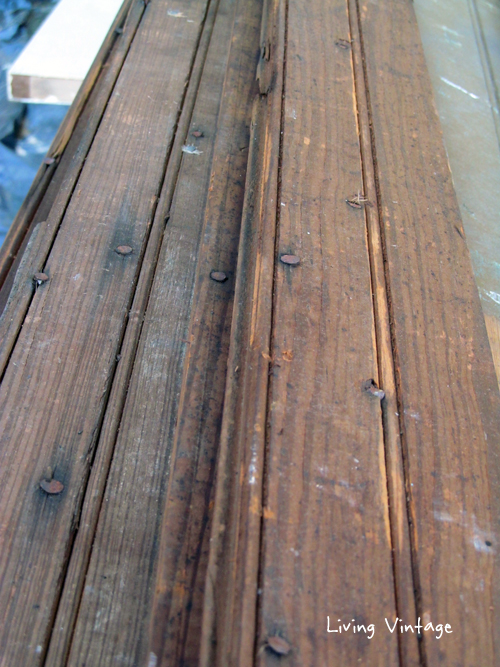

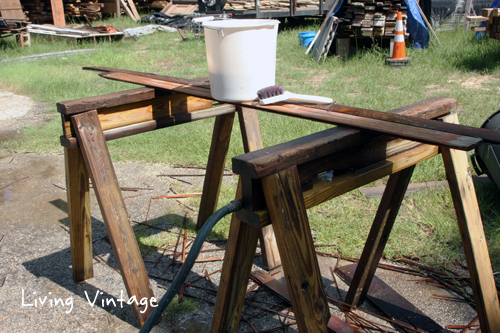

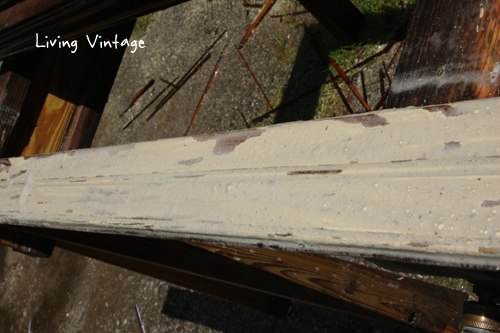
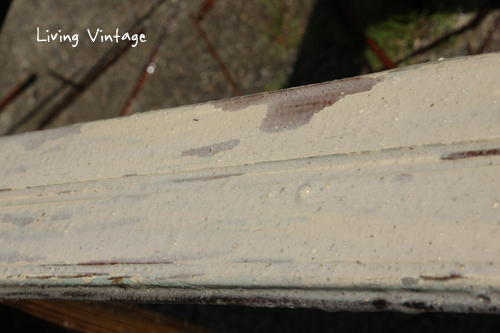







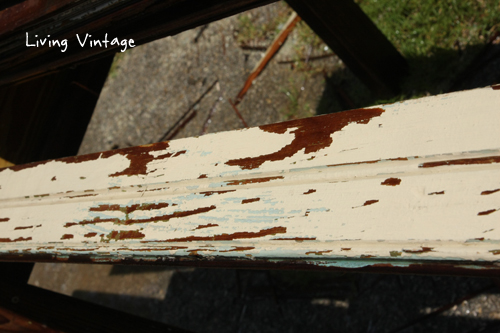

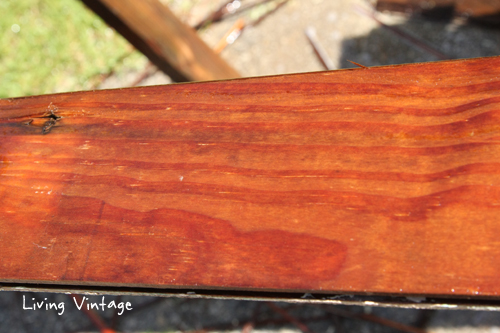

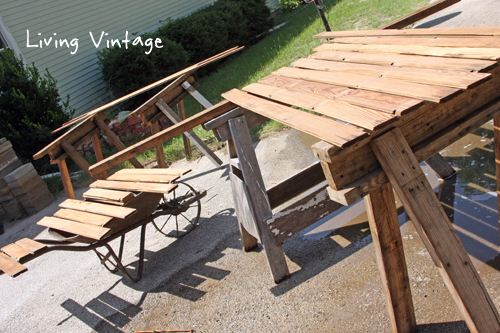


Also, if you have a stubborn nail that won’t come out (without splitting your board), try to remove it once your board is wet. I figured out that they will come right out, once I wet the board down. Of course you don’t want to wait to remove all nails after you wet the board but that helps with the stubborn ones, even the ones that the head broke off, if you can get a pair of pliers on the backside or use a hammer.
What a great tip! Thanks so much for sharing it, Angela!
This is a such a great post! I have all of this old wood lying around, and never thought that I could transform it to like-new condition as you have – thank you.
Hello, I have an old washstand that I thought I might do this with – it’s covered in bird poo and dirt (it had been sitting in a shearing shed). I really don’t want to take to it with sandpaper at all, I just want to clean it and then wax it or oil it. What would you recommend once I’ve cleaned it? I don’t want to seal it with with a polyurethane-based product. I thought perhaps an oil? Any advice you could give me would be much appreciated. Thank you.
Priscilla, I’ve cleaning many pieces of furniture using this method. As long as you allow your washstand to dry completely in the sun, you should be fine. Concerning sealing it, I’d recommend using a natural furniture wax. Google it and you should find lots of options.
Thanks Kim, I’ll probably go with something with orange oil/beeswax or lavender oil/beeswax.
What are your tips for sealing the wood/treating? i am worried that the moisture would attract things like silverfish if the wood is going to be used inside the home. What would you recommend?
Honestly, I’ve never been asked that question before. Perhaps you should ask your local pest control expert. (I’d love to know what they say.) That being said, there is no moisture in the wood if you thoroughly dry it in the sun as shown in the tutorial. Also, I usually paint raw wood OR I seal antique painted wood with oil-based polyurethane. I have no idea if either of those deter silverfish.
What about cleaning beadboard that is on the wall? It has not been painted just years and years of grime. My husband tried sanding to prepare for staining and we are loosing detail in the wood. I would like natural looking wood and not paint them just not sure I can get them clean
Oh my gosh, that’s more difficult, but still do-able, I think. First, I’d spray the beadboard with a household cleaner, maybe a natural one like a Method cleaner. After you wet the beadboard with the cleaner and let it do its work for a few seconds, wipe down the boards with cotton rags. You’ll go through a ton of rags, but they can be bought affordably at Home Depot and they’re re-usuable. (Depending on what I’m cleaning and how filthy the rags are, I wash them in hot water and bleach afterwards, and they almost always come clean.) Then, once the boards are somewhat clean, I’d use a commercial paint stripper product to remove the paint. Then, I would think at that point, they’d be ready for staining. (However, there might be some paint stripper residue still on the paint, so you might want to contact the stripper manufacturer to get their recommendations concerning staining afterwards; that is, if the instructions aren’t on the bottle already!) Just my two cents. Hope this helps! Let me know if it works for you.
I’ve been salvaging old hard wood flooring from a house scheduled for demolition. On my way home I stopped by the car wash to give the pickup a quick wash. Miserable hot, dirty, exhausted, and dreading clean-up of the old flooring and doors in the bed of the truck. You know those !AHA! moments – when a solution is so obvious and so simple, you wanna bop yourself on the head for not realizing it sooner – it was one of those moments.
I unloaded some of the flooring and an old door, leaned them against the wash stall, dropped a few more quarters, -and reduced hours of cleaning to about 15 mins. Thanks to the high pressure wash, the wood spends less time in saturating in water.
The old doors had about 10 different colored paint layers. When I hit the doors really close in a few places with the high pressure water, it blew varying layers of paint off giving me a beautiful chippy look which I fine tuned and cleaned up a bit more at home.
A note of caution – I wouldn’t use this method on any and everything as it could have disastrous results, so consider carefully.
Your method absolutely would work for wood that has good solid paint or no paint at all. (We’ve since invested in a power washer.) My tutorial was written with chippy-painted wood in mind — i.e. I want to retain as much paint as I possibly can!
Hi Kim…I use old reclaimed wood (usually old cedar fencing) for out door sign projects. I clean the wood and paint it with an acrylic paint and then sand it to make the paint look weathered along with the wood. Do you know of an outdoor sealant that will not discolor the signs. I love the old gray look but the sealers I have tried darken the wood and makes it look wet. I’ve tried polyurethane clear sprays and they’re the same. Any suggestions? The signs are made to be out in the weather. Thanks!
I don’t have any suggestions for outdoor use. Sorry!
I was told that the old barn wood needs to be kiln dried to kill any critters / bugs? Can it just be cleaned? I want to use reclaimed wood in our basement.
Thanks!!!
I’ve always just cleaned it, and we’ve never had problems with bugs.
I just did a demo on a bathroom that was an addition to our old our house many years ago. I found behind the drywall was the old wood siding. I would like to keep it as the wall. No paint is on it. Could I use this method to clean the existing intact wall of old wood siding? Thanks!
You could, but it might be messy. Too, you need to make sure the wood thoroughly dries. If it were me and the wood is not too grimy, I would just use diluted bleach (water and bleach in a bucket) or a spray cleaner with bleach and some old rags.
We had some wet fence wood in our garage and of course it got moldy. Husband laid it in the sun for a day – does that make it safe from the mold or does it have to be washed?
If it got moldy, I think I’d still clean it with bleach. My two cents . . .
Thank you!
Hi! Quick question, I’m an artist/painter and I live in Brooklyn NYC so I really don’t have anywhere to leave these old planks to dry. I’m going to do an acrylic old style painting on them once they are primed. Do you know of any other options than sun drying for us city folks? Many thanks!
Hmmm, good point. I guess my answer would depend upon how textured the wood is. If it’s relatively smooth, I’d try to use a spray cleaner (like Lysol) and old rags to clean the boards. If that doesn’t work, try lightly washing them in Dawn dish detergent. Either way, let the boards dry for a day or two under a ceiling fan. That should work.
Sunlamps! (Used ones at Salvation Army) Worked for me!
I will second the posting by “Cat”. I’ve cleaned olde wood and boxes and other vintage things for years with no more than a spray of “409” cleaner and a 1200 psi pressure washer with excellent results and minimal effort. Clearly you have to be sensitive to whether the item has soft areas that might be damaged by too harsh a spray. Very important to do this on a warm day so that drying time is no more than an hour or two. So buy an electric pressure washer and save yourself a huge amount of time and effort……really!
Yes, we’ve since invested in a power washer, and use it to power wash various types of wood where we’re not concerned with paint loss, or like you said, wood that is too fragile. Thanks for the tip, Dave!
I’ve used muratic acid used to clean brick. It bubbles all the dirt out of the small cracks. Naturally gloves n eye protection should b used. Apply ,let bubble rinse.
I have 4,000 sqft of maple we are going to put in our house. It’s over 100 years old and from a cotton mill in Virginia. It’s quite dirty with different sorts of dirt and oil on it. Any recommendations on how to clean such a large amount of flooring? I’m most concerned with getting the joints clean so that it will lay properly, then maybe cleaning the top of the boards after it is laid. Any help is appreciated.
Jeff, it’s hard for me to visualize just how filthy it might be. Also, are you planning to sand and refinish the floors after they’re installed? I assume so. Therefore, if it were me, and it was just dirty on the top side of the boards (i.e. the side you will see after it’s laid), I’d just lay it down “as is”, then mop it with some sort of industrial type cleaner to get some of the mess cleaned up before you start the sanding process. Not cleaning up excessive gunk will just gum up the sanding pads. Clean/mop as many times as necessary to get the worst of the dirt and oil up. Let the floors dry completely before you start sanding.
Hope this helps!
I own some nice reclaimed wood furniture that’s spent a couple years in a storage shed with only partial cover. After returning, I was disgusted to find the floors covered in mouse droppings… I’m interested in disinfecting the wood (to avoid risks like hantavirus traveling in the natural porous cracks/crevices), and was wondering if you had any tips? Can I just put 5-10% bleach into the soapy water and use that? I’m sure it’ll strip the finish, but I can always re-apply once I feel safe bringing it into my home.
Thanks!
Dan, I always splash some bleach in with my dish soap, but I don’t recommend it due to the fumes. Or, you could always wash with dish soap first, rinse, then apply a bleach solution to the wood, let it sit for a few minutes, then rinse again.
I just bought a barn beam for my fireplace, i will be using it as a mantel. I believe the wood is pine. I love the the colour of it since it is over 100 years old. I just would like to know is what can I use to just seal it so when I apply it it won’t change colour.
Mario, I would use a good wax product (like Miss Mustard Seed’s). The wax might darken or enrich the color a bit, but will not change it.
Dish washing detergent is a fantastic idea. I have never used it for cleaning wood. I am going to try it next time. The winter is coming and we should prepare our wood furniture. I am going to use your advice. Thank you for sharing it. Best regards!
Hi- will using your method to clean old barnwood / reclaimed wood strip away the gray color of the wood?
I don’t want to lose that aspect!
Please let me know! It seems totally do-able!
I don’t think so. Test it on one piece of wood to make sure.
It is totally do-able. I’ve cleaned wood like this many, many times.
Have fun!
I just found an old gymnasium floor for sale. It is solid maple. They took great care in taking it apart, but the joints are very hardpacked dirt and more than likely wax buildup from years of waxing it. I have tried scraping it, but almost none comes off. Do you have any suggestions as to what to do to loosen up that type of hardened dirt/wax buildup to make it easier to scrape off? I would assume it would have to soak a long time in water to soften it at all, and of course soaking the wood for that long wouldn’t be good. Other than the grooves, the boards are in excellent reuseable condition. Thank you for any suggestions you may have.
Actually, I do know what you’re going through and I have a suggestion — I had a similar problem when I renovated my home in Austin and bought reclaimed wood floors with hard-packed gunk in the tongue and groove. Try a wire brush — any kind of scratching you use will be remedied when you refinish the floors after they’re installed. If that doesn’t work, try a Dremel tool with the attachment that works for you. That’s what I had to use in Austin. It’s slow and tedious, but it works!
Hi there, I have some cedar siding in the natural color and I’m trying to find a product I can put on it to protect the wood and not change the color like polyurethane does… I don’t like the oranges… It’s a nice natural color and I don’t want to stain it so do you know of anything at all I can use? It looks a lot like hickory does in it’s natural state…
Jo, the only thing other than polyurethane that I can think to use would be a nice quality furniture wax.
I just picked up some 100+ year old interior doors that need a lot of help. My concern is that the paint may contain lead. Have you run into this issue, do you get your wood tested before doing any cleaning?
Mark, yes, you can buy lead-testing kits at Sherwin-Williams or any other paint store. If the doors do contain lead paint, I recommend wearing adequate protection when cleaning the doors. I’m sure SW can give you advice on that as well. 🙂
Hi Kim! This is an excellent and thorough walk-through. Question: I live in the northeast, in Brooklyn, and even though I have an outdoor area (no hose, unforch), it is pretty cold here and I can’t wait until summer. You have warnings about working and drying in the sun, but aside from the discomfort, is there any issue drying the wood out in the cold? Also, do you lightly sand before or after you wash your wood?
Chris,
Aside from the discomfort, I don’t foresee any issues if you dry the wood on a sunny, cold day. (In other words, the wood will not dry if it’s an overcast, cold day.) Also, I do not lightly sand the wood before or after I wash the wood, but you could if you wanted to — this would be a personal preference. I personally like old, “chippy” paint, so I simply paint a coat of clear polyurethane to the wood after it’s installed. This mitigates any exposure to lead-based paint and prevents any future paint from flaking off the wood.
Hope this helps!
Thank you for posting all this wonderful information. I had a quick question. I am getting my reclaimed wood from barn siding and I found someone to put it in a kiln. Do you think it should still be washed if it is kilned or should that be enough to kill off anything in there?
Honey, I don’t have any idea really. Why would you want to kiln it if it’s not wet? I’m afraid that a kiln will get too hot and curl the wood?
What do you do to seal the wood once you create your project out of reclaimed wood? We are trying to build a coffee table, and was wondering if you had any advice on protecting it, without changing the color of it? Thanks
I would suggest using a quality wax or oil if you don’t want to change the color of the wood. When you first apply the wax or oil the color will deepen and become more rich, but that will fade over time. The same thing holds true with using a polyurethane product, but polyurethane can create a yellow-y tinge.
I agree with Kim. You can also get a Bona product (usually used for floors) – Bona Naturale – that has been recommended to me by these guys who design restaurants in brooklyn for a living. The application though is complicated and it goes for $100 bottle, so that my be overkill. It has a dry, matte finish with almost no discernible color change. I went with a wax. Rustoleom also makes a clear matte finish “chalked” product: https://shar.es/1hNHYP. I’ve used that. It works well.
Hi there I have a pair of 100 year old glass French doors that are unpainted wood. They are beautiful but really dirty. I want to clean them prior to staining them. Everything I have read online says I should sand them but I think it would be too hard to get in between the little grooves by the glass. Would this method work? My husband think I should just leave them and I am crazy for trying to wash them as he thinks they will get ruined. Also if it possible how long should I wait to stain them after washing them? Thank you!
I have cleaned everything from furniture to reclaimed wood using my method, and have never had a problem. Now, of course, I can’t guarantee that you won’t, but as long as you don’t allow the allow the water to sit or you don’t dry the doors too long in harsh sun, I don’t anticipate that you will have a problem. As long as the wood is good and dry, you should be able to stain immediately afterwards. I would also sand the doors if the cleaning process raises some of the grain, especially if you want to be able to run your hands over the wood without risk of splinters.
My contractor hung reclaimed barn wood with chipping paint for our project. It’s an old shed we are turning into an office. It has not been cleaned. What now? Can I clean it after it is installed using the method you showed? I want the paint to remain. Once it dries what do I use to seal the wood?
Gosh, that’s a tough one. I guess the answer depends upon if the wood is somewhat smooth or rough. If the wood is smooth, I’d use a bucket full of water with a tiny amount of vinegar or bleach. Dip a rag into the bucket, wring it out well, and wash the walls as if you were dusting a piece of furniture. Rinse and repeat as many times as you like to get the walls clean. Be sure to allow the wood to dry thoroughly before applying a sealant, and speaking of that, I usually use an oil-based polyurethane with a satin finish to seal the wood and the paint. Hope this helps! Good luck.
I am working on a small centennial barn. I would like to clean the inside as I am going to repurpose it into a craft barn. Do you have any suggestions for what to clean the walls with?
We just dismantled an old horse barn and I’d like to reuse the stall-wood for indoor projects. The wood reiks of horse and are muaty. How do you remove the odor from reclaimed wood?
My method will remove most of the smell.
Wanted to do a reclaimed wood accent wall from some old fence boards I found. They were pretty nasty, but I sanded them down and stained them to my liking. Also power washed the areas I didn’t sand down. Then I started reading about how they needed to be heated up to 130 degrees for at least 30 min. to kill all the bugs and larvae. This worried me because I didn’t want to bring anything nasty into my house. Couldn’t figure out how to DIY this until it got really hot outside and I started thinking about how hot the inside of my car was.
I placed all the boards in my SUV and shut the windows. On a 90 degree day, the inside got to about 120 in the car. Still not hot enough! Then I turned the car on and let the heater blast. Within a half hour, the temp got to 145 inside the car! I let it run for about an hour and then checked on it again. Heat inside was now 160! Shut the car off, rolled the windows down, removed the wood and am now extremely happy to know that I won’t be bringing any bugs or larvae into the home. Hope this helps!
Thanks for this post! I followed it and loved the way my barn wood turned out! It was also fairly stinky and triggered my horse allergies! Now it’s good.
I’m wondering if I need to coat the wood before using it for my bathroom vanity mirror? If so, what would you recommend to keep it as natural as possible (husband doesn’t want me to use anything – he’s afraid it will lose character and darken).
In a bathroom setting, I do believe non-protected wood will mold fairly easily (because of the damp air). If I were you, I would coat the cleaned wood in a clear polyurethane — either satin or flat. Once the polyurethane dries thoroughly, you won’t even notice it (at least I can’t and don’t). The satin finish has a VERY slight sheen to it.
Hi Kim brilliant set of instructions..
One question. I live in London where it can be really wet and rainy. How would you say I could go on about drying the wood as we hardly get any sun at this imenof the year? Leaving them to dry in my garage with the heating on?
Honestly, if I lived in a climate like yours I wouldn’t even wet the boards. Wet boards take forever to dry in low sunlight. I would probably just wet rags and clean them as best I could, and I’d probably leave the backside of the boards dirty (or use a dry brush to clean most of the muck off).
Wow, Thank You for writing your article, it’s so helpful, as are your commenters questions & your answers!!
I wanted to give you a tip that I sometimes use to remove old tacks & nails from reclaimed wood. This summer I’d (delusionally) decided to take down an large horse stable, a huge wooden corral & fenced area & 7 three sided wind blocks that my dad had built in the early 60’s. They were dilapidated & not usable for their originally intended purpose… But, because my dad built them? I decided to take great care & preserve as much of the old wood as I possibly could.. I told myself.., ‘Easy Peasy, I can do this in 2 weekends max + my husband has all sorts of tools & this will be a fun project for me..’.. Well blah blah blah, 4months later (working daily) & I’d finally finished tearing everything down.. BUT, I’m still pulling the last of the nails, cleaning, stacking & storing a seemingly endless supply of reclaimed wood (it’s November).
So along my journey, through what at times, has felt like I may be on the cusp of discovered Daunte’s 11th ring of Hell? I’ve had to, read, learn & teach myself all sorts of tricks that could help my task go a little smoother & hopefully a little quicker..
Now to the rusty nails & tacks removal… you know, where the heads seems to disintegrate with a pull of a pry bar, hammers, tack remover or gloved fingers? So here’s what I do….Depending on the thickness of the board, I take a straight nail that is the same width or less than the nail/tack I need to pull. Then I take my hammer, hold my nail over the old nail & just smack my nail a few times. Then I flip my board & pull the old nail out, with either a pair of pliers or my fingers..
In fact, because this works so well (for me anyway)?? I started just taking a SawZa, sliding it between the nailed boards as the structures were still standing & I’d would quickly cut all the nails at once, instead of pulling them one at a time, as the structures stood.. Doing this has allowed me to save a lot more of the wood than I ever could have before.. And it cut my nail & tack pulling time easily by 2/3rd’s..
Hope this silly little trick helps you with those stubborn ol’nails too 🙂
I loved your story and thanks so much for the tip!
Kim, thanks for all you insightful comments and feedback. I recently purchased a cottage that is about 120 years old. At some point an addition was placed to the side of the house but the siding was left. I peeled away all the siding (asphalt shingles with cork and horsehair backing) and underneath shingles was the original wood siding tacked onto big beams of wood. I pulled off some of these to find they are brittle and with bug nests behind. I suspect the wood is cedar due to lack of bug activity through the wood (only behind). The face of the wood is a beautiful, gray, aging look. I want to take all of these down and create an accent board wall. Will it be enough to clean using the method you outlined and if so, do you recommend any kind of sealing once he wood is up again?
Without seeing the wood in person, I hesitate to guarantee that my cleaning method will be all that you need to do. However, I’m pretty sure it will be. I’ve cleaned many, many filthy boards using my method and it’s always worked for me. If the wood was painted, I’d say “yes, absolutely” because a coat or two of polyurethane will eliminate any risks due to lead-based paint exposure and it will practically eliminate any paint from flaking off. However, if the wood is natural, sealing it is up to you. Sealing will just add a little bit of a patina based on the type of sealer you use — a satin finish, for example, will leave a slight sheen once it’s dry. Plus a sealant will make the color of the natural wood look a little darker and more “rich”.
Hi Kim,
I would like to link to your story on my blog: http://TheAverageDan.com with your permission.
Please let me know if that is ok with you.
Thank you,
The Average Dan
As long as you provide credit and link back to the post on my blog, that is fine.
I am working on trying to “restore” antique wooden ladders for storage use (blankets and scarves) around my home. I’ve cleaned them using Murphys and steel wool per someone else’s direction. I’ve hand and mouse sanded but I still have a load of splintering occurring, small and large chunks. Any advice? I’ve seen the wood glue advice but it’s not just one bit.
Mark will email you directly about this!
We recently bought a home that has all it’s interior doors made from a dairy farmers steer corral wood. The house has that musty stale smell that I think comes from these beautiful rustic doors. The doors are heavy as they are about 1 1/2 to 1 3/4 inches thick.
My question: Can I use your cleaning system by taking the doors outside and following your cleaning steps? My only fear is that if the wood changes shape at all, they will fit the door frame.
Thanks for any advice.
I do believe you can use my cleaning method, and I don’t believe the size of the wood will shrink or change, especially given the thickness of the wood. However, it’s hard to say not seeing it in person. It’s totally your call but my cleaning method should get rid of any musty odor.
Loved your article! I’ve found some gorgeous 100-year old barn wood and am hesitant to sand much so I don’t lose the original texture! The idea is to put a stain to make it a rich brown, could you recommend how much to sand and type of stain to achieve my look?
It’s really a personal preference thing concerning how much you sand it. Personally, I like old wood to be somewhat sanded because dusting it later on down the line will be easier. I’ve always used Minwax stains in darker tones. I think their “walnut” stain is the one I’ve used before, if I use any stain at all. Old wood has a natural, dark patina all its own so I sometimes choose just to clear coat the wood. Hope this helps!
I have a old piece of pine that’s laid outside for years it’s quite thick. I want to use it to make a small counter top. It has turned gray due to the elements but once cleaned using your method do you no of a good way to seal it for use as a kitchen counter top?
Thanks for posting this with all the pictures and sample materials. It gave me a lot of confidence. We just took down about 60+ linear feet of funky painted old deck rail and I want to panel an alcove with some of it. You gave me some good ideas!
I’m so glad that my tutorial may be helpful for you. Good luck with your projects!
We put up a barnwood wall in our living room but it still has a musty smell to it. I washed it with dishwasher soap as instructed and let it dry thoroughly. How can I get the smell out? I love rustic and shanty chic but NOT the smell of it.
Stephanie, I’m sorry, but I’ve never, ever had that problem and I don’t know how to tell you to fix it. Are you sure the wood was dried thoroughly? If so, maybe you have a super sensitive nose. Sorry! Wish I could be more help.
Our cedar-wood deck is two years old and turning gray You can see the color when it rains. Will these steps bring some of the color back? (minus the steps for drying)
I doubt just cleaning it will bring the color back. Have you tried applying a polyurethane or wax or some other type of cedar wood product to it?
I recently moved into a 1937 cottage at the beach in FL. The floors are beautiful cedar narrow plank. They need no major work. I was going to mop them with plain water. Is that okay and should I add a few drops of Dawn and or vinegar to the water? Any other suggestions? Linda
Personally, I’d try a cleaner specifically made for wood floors. Check with Home Depot, Lowe’s or a flooring specialist.
Very interesting points you have noted, regards for putting up.